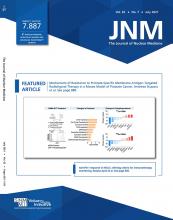Discussions with leaders: JNM editor-in-chief Johannes Czernin, with Thomas Hope, continues a series of interviews with leaders in nuclear andmolecular imaging and therapy in a conversation with Lou Marzella, MD, PhD, about FDA perspectives on radiopharmaceutical agents.
Page 881
Pharmacogenomics in radionuclide therapy: Scott and Bodei provide an overview of the importance of considering individual germline and somatic mutations, as well as gene expression profiling, in predicting efficacy and toxicity across the spectrumof radionuclide treatment strategies.
Page 884
Nuclear medicine in benign thyroid disease: Mariani and colleagues offer an educational review of clinical manifestations, pathophysiology, imagingmodalities, and therapy of nontoxic nodular goiter, hypothyroidism, and thyroiditis.
Page 886
Immunometabolism and atherosclerosis: Mannes and Tavakoli focus on recent advances in understanding of immunometabolism of atherosclerosis, with an emphasis on macrophages, and preview promising metabolic imaging approaches using 18F-FDG and other PET radiotracers.
Page 896
Nuclear medicine in The Netherlands: Czernin and Herrmann look at the implications of the 2015 creation of combined Dutch nuclear medicine and radiology residencies, specialty boards, and program review committees.
Page 903
Dutch integrated residency training: Velleman and colleagues report on the results of a questionnaire exploring the reasons that residents chose to enter the nuclear medicine subspecialty in the integrated nuclear medicine and radiology residency programin The Netherlands.
Page 905
Cognitive recovery in chronic COVID-19: Blazhenets and colleagues correlate clinical cognitive assessments and 18F-FDG PET images from COVID-19 patients at subacute and chronic stages to examine the time-course of post-COVID impairment.
Page 910
Beyond VISION: Fendler and colleagues detail the likely future effects of positive results announced earlier this year for the randomized phase III Vascular Events in Noncardiac Surgery Cohort Evaluation study on 177Lu-PSMA-617 radioligand therapy.
Page 916
18F-FET PET for temozolomide monitoring: Ceccon and colleagues compare the value of contrast-enhanced MR imaging and 18FFET PET for response assessment in glioma patients after adjuvant temozolomide chemotherapy.
Page 918
Anti-PD-1 response in NSCLC: Ayati and colleagues explore correlations between survival outcome and response assessment by PERCIST (version 1.0), immunotherapy-modified PERCIST, RECIST (version 1.1), and immunotherapy-modified RECIST in patients with non–small cell lung cancer.
Page 926
11C-Sorafenib and 15O-H2O PET: Mammatas and colleagues investigate whether 11C-sorafenib and 15O-H2O PET have potential to predict sorafenib treatment efficacy in patients with advanced solid malignancies.
Page 934
PARP1 cervical tumor identification: Demétrio De Souza França and colleagues describe the use of a fluorescent PARP1 inhibitor as an optical imaging agent to specifically target PARP1 expression, with potential to improve identification of tumor cells during colposcopy.
Page 941
Iron-targeted theranostics for cancer: Zhao and colleagues test whether tumor uptake of the novel cytosolic labile iron pool–sensing radio-tracer 18F-trioxolane aligns with tumor sensitivity to LIP-targeted therapies.
Page 949
Imaging calreticulin to detect cell death: Kim and colleagues assess the use of a calreticulin–specific binding peptide for imaging ecto-CRT during immunogenic cell death and its utility for early prediction of treatment response.
Page 956
PSMA PET/CT in BCP: Meijer and colleagues report on a study designed to determine the role of 18F-DCFPyL or 68Ga-PSMA-11 PET/CT imaging in patients with prostate cancer who experience biochemical persistence after robot-assisted laparoscopic radical prostatectomy.
Page 961
Correct detectionrate of 18F-rhPSMA-7 for BCR: Chantadisai and colleagues use composite validation to describe the detection rate, positive predictive value, and correct detection rate of 18F-rhPSMA-7 PET/CT in biochemical recurrence of prostate cancer after radical prostatectomy.
Page 968
RLT in prostate cancer: Prasad and colleagues present results on 2 case experiences with the synergistic effects of immunotherapy with pembrolizumab or sequentially after olaparib to overcome the limitations of radioligand therapy with 177Lu-PSMA in metastasized castration-resistant prostate cancer.
Page 975
213Bi- and 225Ac-based radiotherapeutics: Banerjee and colleagues synthesize 213Bi-and 225Ac-labeled a-particle–emitting analogs of a low-molecular-weight compound for preclinical evaluation in PSMA-targeted treatment of prostate cancer.
Page 980
PSMA RLT proteomics/phosphoproteomics: Stuparu and colleagues investigate the proteome and phosphoproteome in a mouse model of prostate cancer to identify signaling adaptations triggered by PSMA radioligand therapy.
Page 989
β-Receptor in chronotropic incompetence: Goto and colleagues explore cardiac β-adrenergic receptor density in patients with chronotropic incompetence without heart failure using 11C-CGP12177 cardiac PET.
Page 996
Universal readout of 18F amyloid tracers: Bischof and colleagues document the comparability of 3 approved visual rating protocols to classify a scan as amyloid-positive or -negative, as applied by groups of experts and non-experts to all 3 amyloid tracers.
Page 999
Single-time-point dosimetry: Hou and colleagues analyze 2 single-time-point dosimetry methods, evaluate dose errors for several radiopharmaceuticals based on effective halflife distribution, and make recommendations for improved personalized dosimetry using simplified imaging schemes.
Page 1006
132La/225Ac theranostics: Aluicio-Sarduy and colleagues describe preclinical work exploring the utility of 132La as a PET imaging surrogate for 225Ac using a DOTA-based, tumor-targeting alkylphosphocholine.
Page 1012
Liver enzyme elevation after 177Lu-PSMA: Treiber and colleagues detail the case study of a patient presentingwith adverse events after 177Lu-PSMA radioligand therapy for castration-resistant prostate cancer.
Page 1016
- © 2021 by the Society of Nuclear Medicine and Molecular Imaging.







